The voice of the kōkōhau
This year’s winning Brick Bay Folly, ‘Te Reo o te Hau’, ‘The Voice of the Kōkōhau’, asks us to listen to the voice of the wind and explore the kōrero it has with its surroundings. Amanda Harkness investigates.
As the wind makes its way across the moana and over the whenua, its voice at times deafening, at times a mere whisper, there is much to celebrate about its presence. Its breath carries the wings of migrating birds, disperses seeds to distant sites and encourages tree roots to deepen.
When team members William Creighton, Chris Gandhi, Matt Green and Seth Trocio, all graduates of the Victoria University of Wellington School of Architecture, gathered to research site and context for their folly submission, they came across the term ‘mangatāwhiri’, which refers to the wind that sweeps across the bay at nearby Omaha Beach.
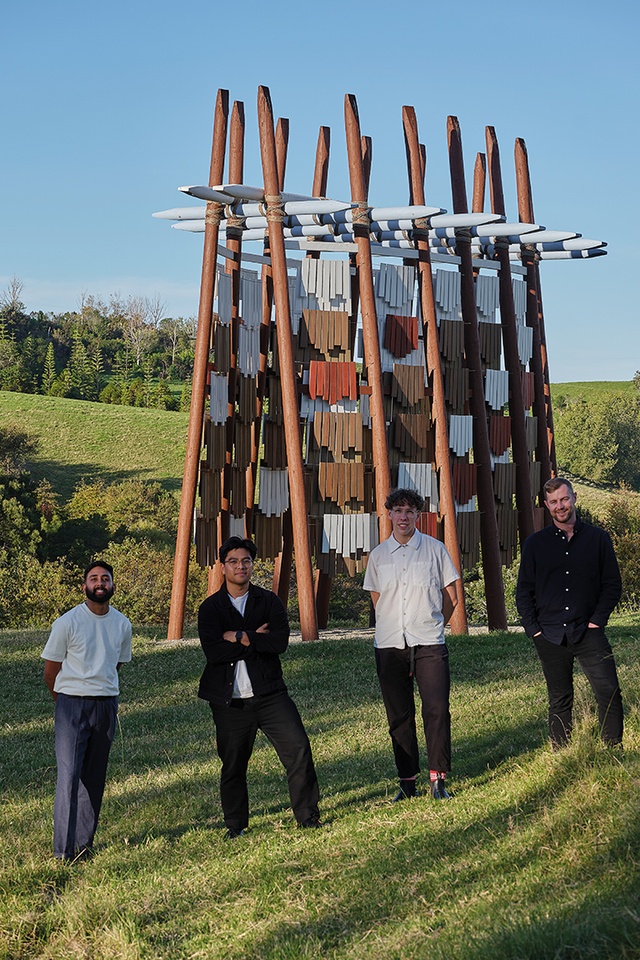
“We wanted to explore how that wind could be encapsulated within our folly,” explains Gandhi. “We were drawn to the idea of operability and movement, rather than to creating a fixed entity.”
“We also became aware of the history of boat-building that took place on site,” adds Green, “and the art of waka construction ultimately helped set the basis for our structure and informed how some members came together through poles and lashings.”
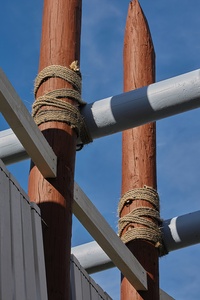
The team’s initial design presented a six-metre-high kākahu (cloak), lifted above the landscape as if lightly draped over a structure. As the wind passed through the kākahu, the timber feathers would move, producing a wind chime-like sound and offering visitors an audible connection to the kōkōhau (wind).
After winning the competition, the team created a prototype of its design, using recycled pine pallets but the resulting sound as they moved in the wind was not as clear as had been hoped for. The folly mentors suggested that an alternative timber, such as kwila, would produce a brighter sound. Not wanting to source the rainforest timber in its virgin state, Green began collecting or, in his words, “scavenging”, recycled kwila from old decks in Christchurch after a search on TradeMe and Facebook Marketplace. “The best part of that was the timber had its own history,” he says. “All the variations and the different ages show through when you’re standing up close to the folly — it’s gone through a lot of hands and that’s what makes it so cool.”
Further advice from the mentors saw the folly’s scale increase both vertically, from six metres to eight metres, and in length, from four bays to six bays, to give it greater presence on site. With the increased size, the proposed 550 kwila panels or shingles that make up the feathers of the cloak now numbered closer to 1000.
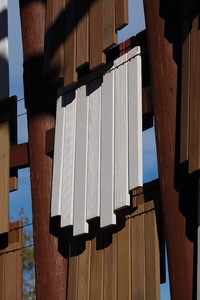
Trocio was responsible for moving the recycled timber, first from Christchurch to Wellington, and then to Auckland, in order to share the workload on the panels. These shipments in themselves proved a feat in logistics, budgeting and project programming.
Every panel had to be denailed, cut, sanded, painted or stained, transported and then installed, with two screws connecting each one to the wire and two aviary clips for equal spacing.
Previously a qualified builder, Green spearheaded the full-scale testing of the folly at Cassidy Construction in Ōtautahi, with the rest of the team joining him to help in the process. He noted that the original proposal to layer the shingles over the top of one another hindered their movement so the design was revised to become two separate rows or layers. This provided an outside pattern and an inside pattern — the inner layer made up of larger, mainly white panels.
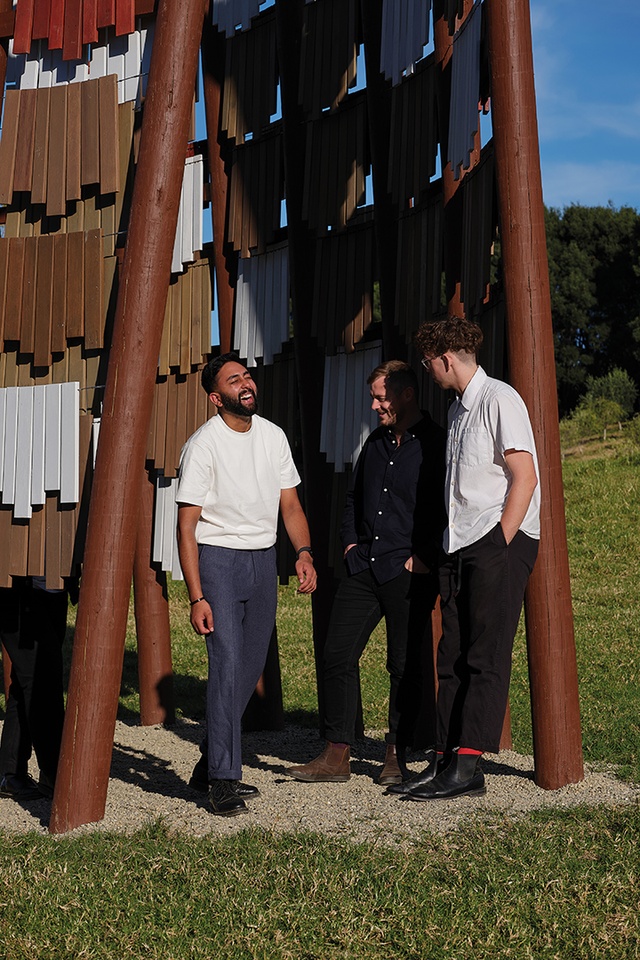
Earlier kōrero with Delma O’Kane from Ngāti Manuhiri Settlement Trust saw the team gifted a pūrākau (mythological narrative), which informed the patterning on the kākahu. “We wanted it to reflect a kākahu,” says Creighton. “As you enter, it’s like a cloak of manaaki. It’s ephemeral but also grounded in the cultural narrative of the site. Nearby Te Hauturu-o-Toi (Little Barrier) is the final resting place of the God of Winds and a cloud rests over it, almost like a crown.”
White feathering fringes the top of the folly and a diagonal pattern appears to run through it, which gives the effect of the folly lifting as the wind from Te Hauturu-o-Toi pushes under it. The feathers of the cloak are painted in three different hues of brown, a red and a white, all from Resene.
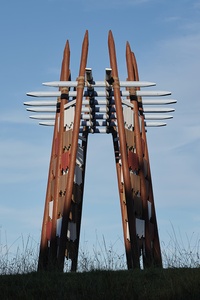
Creighton points out that, as the work shifted from concept to actual build, the team had to deal with the logistics of gravity and physics, where tension wires and dwangs came into play. Trocio mastered and tested the lashings in Wellington and Gandhi was responsible for securing the half-kilometre of custom-dyed, charcoal-grey rope on site, covering the structural bolts and emphasising the connection of the members.
There is some irony in the fact that Cyclone Gabrielle, one of the worst weather events to hit the country in the last century, struck as the team was installing Te reo o te Hau. But the members are quick to point out that the challenges posed by the extreme weather brought them closer as a team, strengthening their resolve, and their understanding and appreciation of one another’s talents.
What is perhaps most impressive about this year’s folly team is the expertise in planning evident throughout the project. This is the first Brick Bay Folly team since 2015 that has not been based in Tāmaki Makaurau. Somehow, despite living and working in different cities on different islands, the team managed, successfully, to complete construction on time and within budget.
“This year’s folly superbly fulfils the challenges laid down by Brick Bay,” says folly judge and mentor Pip Cheshire. “It has a strong idea founded on the cultural history of the site, a complex logistical exercise involving a team strung out over the lower half of the country and a do-or-die goal of harnessing the wind.”
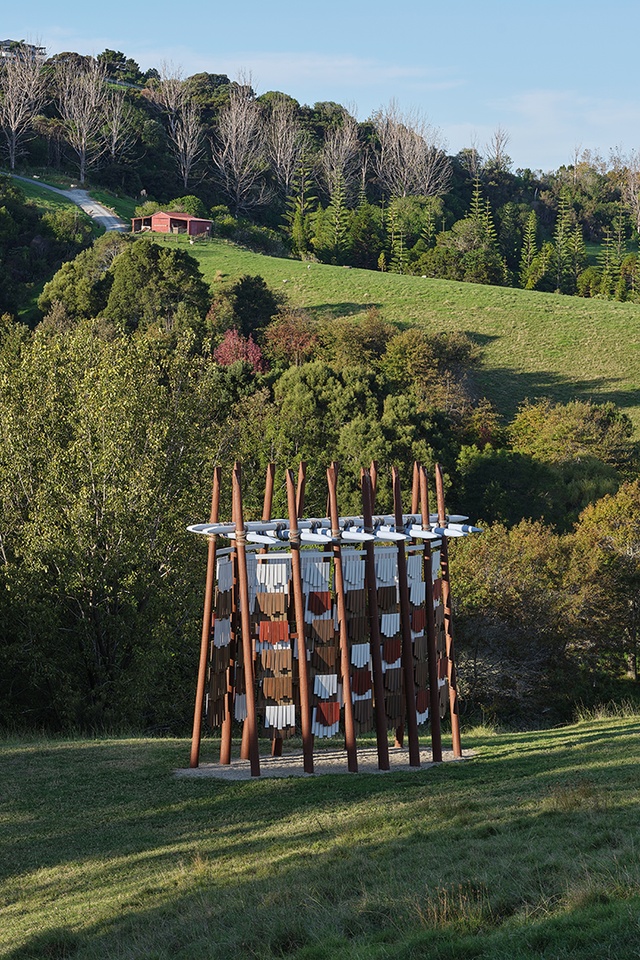
“The folly project challenges teams to take their glossy competition renders and work through the big issues of supply, structural integrity and cost control: a process that invariably ends in the minutiae of counting screws and metres of rope before the graft of fabrication and assembly. All of that can amount to little unless the end result stirs our imagination.”
“We mentors were worried about the detail that would allow the timber ‘feathers’ to move and clatter in the wind; that the team has achieved this and brought the folly to life is a testimony to their creativity, persistence and hard work,” says Cheshire. “It is a fine piece.”
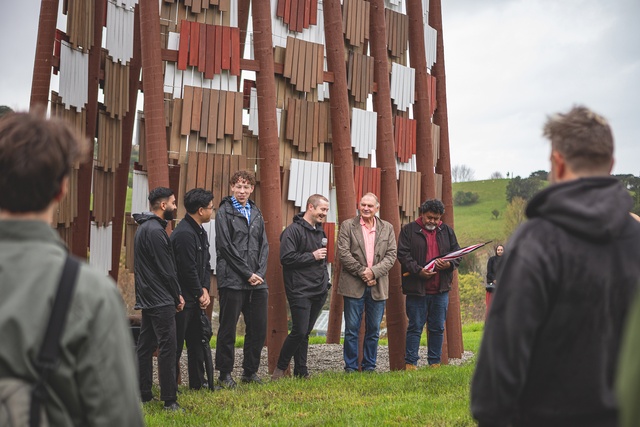
This year’s judges were Pip Cheshire from Cheshire Architects, Steve Cassidy from Cassidy Construction, Hadleigh Armstrong from Resene, Peter Boardman from Structure Design, Keith Mann from Unitec, Chris Barton from Architecture NZ, Richard and Anna Didsbury from Brick Bay, and Nicholas Rowsby from the 2022 Folly winning team, whose folly was named The Nest.
Brick Bay Folly is sponsored by Resene, Cassidy Construction, Cheshire Architects, Structure Design, Brick Bay, Unitec, Architecture NZ, ArchitectureNow and Sam Hartnett Photography.









